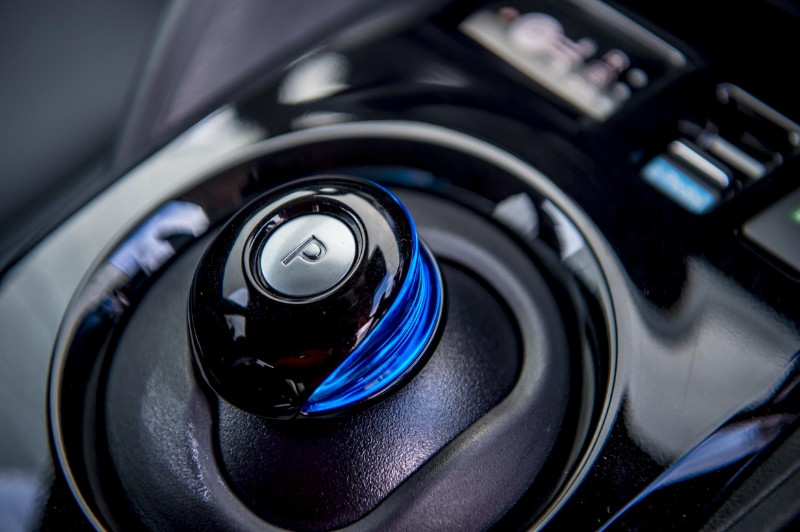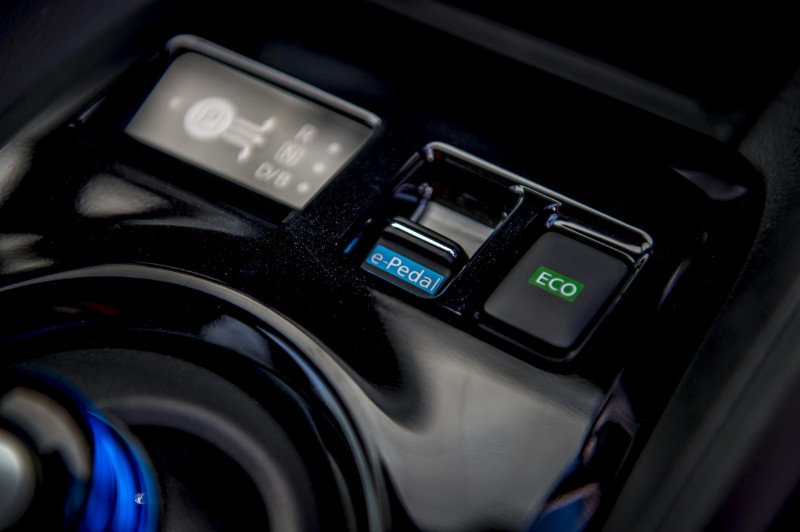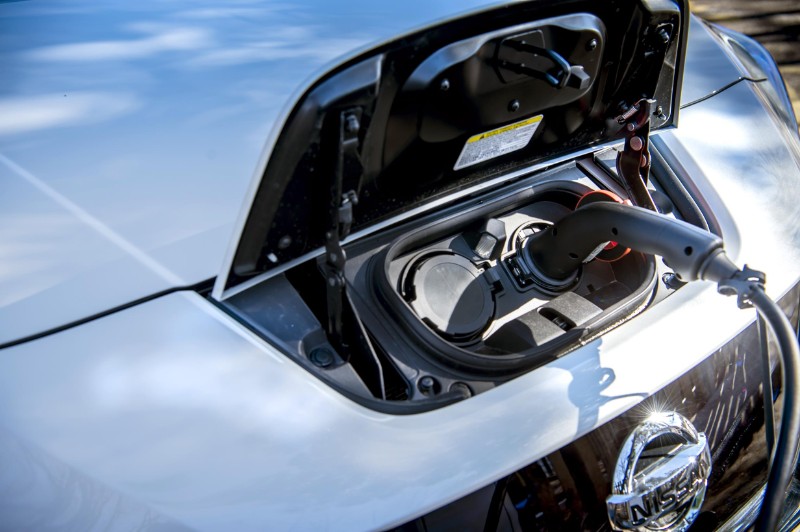While most car brands are planning to release their own electrically powered models over the next few years, Japanese manufacturer Nissan is already on the second generation of its fully electric five-door hatchback. The Nissan LEAF is Ireland and Europe’s best selling electric car. Its main rivals in Ireland are the Renault Zoe, Volkswagen e-golf and Hyundai Ioniq. I drove the new 2018 Nissan LEAF for a week, and it is the first fully electric vehicle I have driven.
Exterior Design
On first look of the new 2018 Nissan LEAF you will notice that the exterior is a lot sharper and more aerodynamic looking than the previous model. From the redesigned grille, sharper headlights to the ‘floating roof’ design the new LEAF has a newly inspired, higher quality look.
The standard SV model comes with a number of exterior features including 16-inch alloy wheels, LED daytime running lamps and privacy glass. The SVE model I tested comes with 17-inch alloy wheels, LED Auto Headlights and 2 tone colour options.
Inside the LEAF
When I first sat into the Nissan LEAF I noticed the interior was extremely spacious, with plenty of head and leg room in the cabin. When sitting in the driver’s seat I was surprised to be in such a high driving position, it almost felt like I was in a small SUV and not a hatchback.
Before I took off, as I always do, I connected my phone to the in-car infotainment system. This process was quick and simple connecting via Bluetooth. The LEAF’s infotainment system though I found to be quite basic, this includes the audio and navigation. But as in most new cars these days you can connect to Apple CarPlay and Android Auto via USB which allows you to use Google maps, Spotify and iTunes.
The SVE model I drove included a 360-degree camera and reversing camera which really assists you when parking, although the resolution is quite low and can be hard at times to see.
Driving the LEAF
Driving the LEAF is very straight forward using the knob in the centre console to switch between Drive, Reverse and Park. Achieving 0-60mph in 7.9 seconds, you can really feel the acceleration when you take off. And as with all electric cars there is little or no noise from the electric motor, you can just about hear the humming from the speaker at the front of the car that Nissan put in to warn pedestrians.

There are a number of interesting driving features in the LEAF, the first one I tried out was the e-Pedal which is available as standard. The e-Pedal allows the car to accelerate and brake using the same pedal. When the e-Pedal is turned on (via a switch on the centre console) the accelerator becomes a lot stiffer and when pressure is taken off the car comes to a slow stop. This feature works really well in traffic, cutting out the need to switch from pedal to pedal whilst saving energy at the same time.

SV Premium and SVE models also come with Nissans innovative ProPILOT technology. This feature is said to be a first step for Nissan toward autonomous driving. The advanced driver assistance system uses lane recognition, radars and cruise control to take control of the car on motorways and even stop/start traffic. The SVE version I drove even came with ProPILOT Park where you can pick a parking space and allow the LEAF to take control and park itself.
Charging the LEAF
According to Nissan and the new European WLTP testing cycle the 40 kWh LEAF has a range of 270 KM. This distance will differ depending on your driving style, weather conditions etc…
When I received the LEAF it was at 82% charge which displayed a 170 km range on the display. This meant I would get a couple of days without having to think about charging. Although even when the battery was more than three quarters charged I still found myself glancing at the battery display every now and then just to check I wasn’t running low.
On the third day of driving, the car was at 18% battery and I decided it was time to charge. There are two types of chargers available, a 7-kW home charger or on street public charger which will take 6-8 hours to fully charge from empty or a 50kW quick-charger which provides 80% charge in just 40-60 minutes.

To charge the LEAF you must have an ecar charge point access card from the ESB. You apply for this very easily by contacting the ESB and providing them with the registration details of your electric vehicle and they will send you a card typically within three days.
The closest charging point to my office in Sandyford was at Stillorgan Luas stop (approximately 750 meters away). But when I searched for charging stations on the in-car navigation system, it said the nearest charging point was 3.4km away.
The first time I arrived at this particular charging point I noticed there were a total of six spots available, to which four were occupied. I decided to pull up to the 50kW quick charger, so I would only need to leave the car parked for an hour or two, as I had just found out that at this car park you have to pay for parking also.
To charge the LEAF you need to open the flap at the front of the car where the sockets are located. To do this you simply press the button on the right-hand side of the steering wheel. If you are using the quick-charger the lead is attached to the charging point, so you can just plug this in from here. If you are using the AC charging point you must use your own lead, this is located in the boot of the car. Once you have connected to the charging point, all you need to do next is tap your ecar charge point access card and the charge commences.
Unfortunately, when I went to commence the charge at this particular station I received an error message stating that the quick-charger was ‘out of order’. This obviously was not ideal but at least I knew there was a free spot at the AC charging point, so I proceeded to move the car here. To my surprise again after I had connected to the AC charging point this did not work either. For some reason the reader would not recognise my access card. After this I decided to just return with the car to the office and worry about charging it somewhere else later.
That evening I went to another charging point reasonably close to my house in Kimmage and commenced charging quick and easy without any issues, although I did have to walk approximately 15 minutes to my house afterwards.
If you are buying a LEAF I would definitely recommend getting a home charger. SEAI currently provide a grant of €600 for home charger installation. More info can be found on their website. https://www.seai.ie/grants/electric-vehicle-grants/electric-vehicle-home-charger-grant/
Verdict
The new Nissan LEAF with its smooth, silent drive and comfortable interior makes sitting behind the wheel a pleasurable experience. Packed full of innovative technology and safety features, you get more than enough for the price. The design of the LEAF is not as appealing as the Volkswagen e-Golf or even Hyundai Ioniq but it is practical and spacious. There is no doubt as to why this the LEAF is the best-selling electric car in the world and should be for the next couple of years at least.
Pros: Silent, Smooth drive. Decent range. Spacious Interior
Cons: Limited Infotainment. Overall Exterior Look. Quality and quantity of charging points in Ireland.
Model driven: Nissan LEAF SVE 40KW
Price From: €28,690
Test Car Price: €32,600
Government Grant: €5,000
Annual Road Tax: €120
Engine: Electric
Power: 150bhp
Top Speed: 143km/h
0-100km/h: 7.9 seconds
Transmission: Automatic
Body style: Hatchback
Boot Space: 435 litres
Competitors: Renault Zoe, Volkswagen e-golf, Hyundai Ioniq